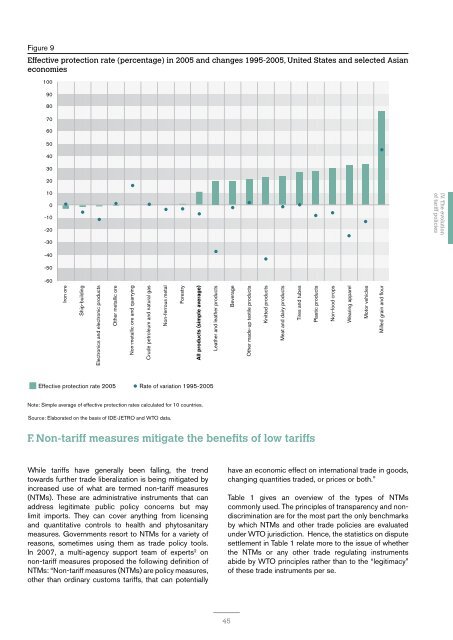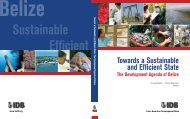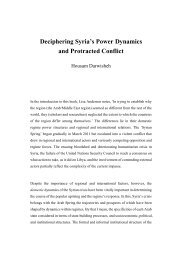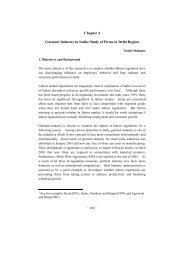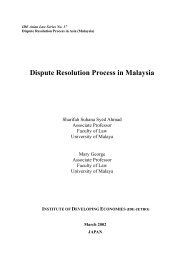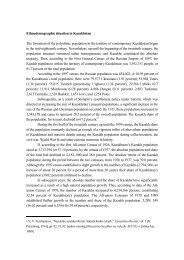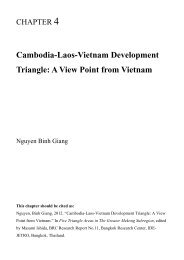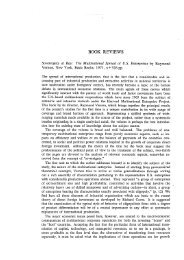Trade patterns and global value chains in East Asia: - IDE-JETRO
Trade patterns and global value chains in East Asia: - IDE-JETRO
Trade patterns and global value chains in East Asia: - IDE-JETRO
Create successful ePaper yourself
Turn your PDF publications into a flip-book with our unique Google optimized e-Paper software.
Figure 9Effective protection rate (percentage) <strong>in</strong> 2005 <strong>and</strong> changes 1995-2005, United States <strong>and</strong> selected <strong>Asia</strong>neconomies1009080706050403020100-10-20I. From massdem<strong>and</strong> to <strong>global</strong>supply <strong>cha<strong>in</strong>s</strong>II. Organizationof the <strong>global</strong>production processIII. Infrastructureservices <strong>in</strong> <strong>global</strong><strong>value</strong> <strong>cha<strong>in</strong>s</strong>IV. The evolutionof tariff policies-30-40-50-60Iron oreShip-build<strong>in</strong>gElectronics <strong>and</strong> electronic productsOther metallic oreNon-metallic ore <strong>and</strong> quarry<strong>in</strong>gCrude petroleum <strong>and</strong> natural gasNon-ferrous metalForestryAll products (simple average)Leather <strong>and</strong> leather productsBeverageOther made-up textile productsKnitted productsMeat <strong>and</strong> dairy productsTires <strong>and</strong> tubesPlastic productsNon-food cropsWear<strong>in</strong>g apparelMotor vehiclesMilled gra<strong>in</strong> <strong>and</strong> flourV. Foreign direct<strong>in</strong>vestmentVI. IntegrateddiversityEffective protection rate 2005 Rate of variation 1995-2005Note: Simple average of effective protection rates calculated for 10 countries.Source: Elaborated on the basis of <strong>IDE</strong>-<strong>JETRO</strong> <strong>and</strong> WTO data.F. Non-tariff measures mitigate the benefits of low tariffsWhile tariffs have generally been fall<strong>in</strong>g, the trendtowards further trade liberalization is be<strong>in</strong>g mitigated by<strong>in</strong>creased use of what are termed non-tariff measures(NTMs). These are adm<strong>in</strong>istrative <strong>in</strong>struments that canaddress legitimate public policy concerns but maylimit imports. They can cover anyth<strong>in</strong>g from licens<strong>in</strong>g<strong>and</strong> quantitative controls to health <strong>and</strong> phytosanitarymeasures. Governments resort to NTMs for a variety ofreasons, sometimes us<strong>in</strong>g them as trade policy tools.In 2007, a multi-agency support team of experts 2 onnon-tariff measures proposed the follow<strong>in</strong>g def<strong>in</strong>ition ofNTMs: “Non-tariff measures (NTMs) are policy measures,other than ord<strong>in</strong>ary customs tariffs, that can potentiallyhave an economic effect on <strong>in</strong>ternational trade <strong>in</strong> goods,chang<strong>in</strong>g quantities traded, or prices or both.”Table 1 gives an overview of the types of NTMscommonly used. The pr<strong>in</strong>ciples of transparency <strong>and</strong> nondiscrim<strong>in</strong>ationare for the most part the only benchmarksby which NTMs <strong>and</strong> other trade policies are evaluatedunder WTO jurisdiction. Hence, the statistics on disputesettlement <strong>in</strong> Table 1 relate more to the issue of whetherthe NTMs or any other trade regulat<strong>in</strong>g <strong>in</strong>strumentsabide by WTO pr<strong>in</strong>ciples rather than to the “legitimacy”of these trade <strong>in</strong>struments per se.VII. An evolutionaryperspective onproduction networks<strong>in</strong> the <strong>Asia</strong>-US regionVIII. <strong>Trade</strong> <strong>in</strong><strong>in</strong>termediate goodsIX. Vertical trade<strong>and</strong> trade <strong>in</strong><strong>value</strong> addedX. Cross-regionalspillover ofeconomic growth45


